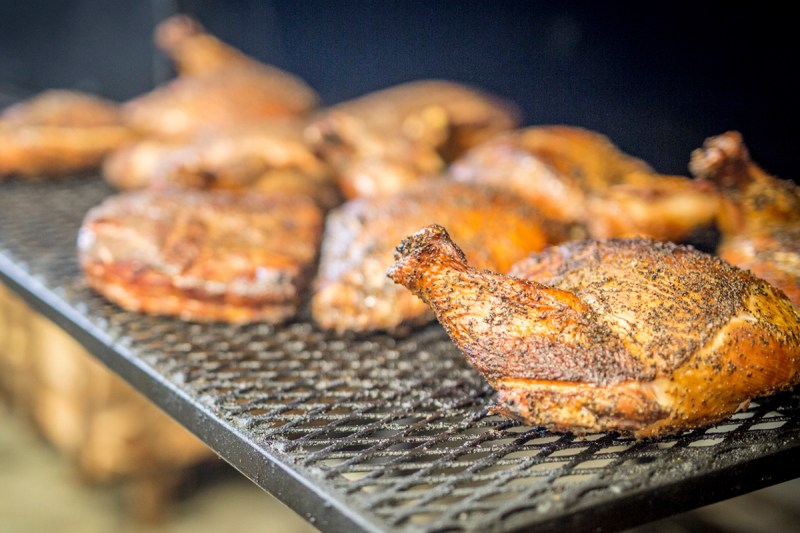
Thanksgiving is fast approaching. Hopefully by now, you’ve started planning the scrumptious dishes you’re going to prepare, and most importantly how you are going to cook the turkey this year. If you’re not cooking a turkey, you’re in the minority as on Thanksgiving alone, 46 million turkeys are consumed by hungry mouths everywhere. If you’re at all worried about gathering during COVID times, check out our tips for hosting a socially-distanced Thanksgiving.
The real question — if you’re indeed getting (or have already purchased) a turkey — is how to prepare it. Sure, you could throw it in the oven or you could even deep fry it — but why not try some alternatives to roast turkey this year? Why not smoke that bad bird? In the past, we’ve covered how to smoke meats in general, but with the holiday ahead of us we decided to really dig in and figure out how to smoke a turkey the right way every time (if you have turkey for the Christmas holiday, too, you could consider Thanksgiving a trial run).
The thing is, we’d never smoked a bird before, but thankfully we knew someone who has smoked many a turkey in his time. To find out how not to mess up the centerpiece of a meal when you may potentially be around all of your family members (including judgmental Aunt Carol), we spoke with pitmaster Anthony DiBernardo of Swig & Swine in Charleston, South Carolina.
If DiBernardo’s name sounds familiar, it’s because he has previously been a guest on The Manual Podcast (formerly Beards, Booze, and Bacon), which you should check out — perhaps download it to listen to on your way to pick up a turkey?
10 Tips for Smoking a Turkey

- Use fresh, not frozen — Hit up your local butcher and splurge a little. If you start with the best quality, you end with the best quality. (Plus you won’t have to worry about defrosting.)
- Handle safely — This is raw poultry, so handle accordingly. No one wants salmonella during Black Friday shopping.
- Don’t stuff your bird — You’ll want the smoke to penetrate the cavity, too.
- Put a drip pan under your bird — This will catch the drippings to use later for gravy, which is a staple of Thanksgiving and should not be skipped over!
- Use a digital thermometer — Fast and accurate readings mean less time spent with your smoker open. On a turkey, you’ll want to check the temperature at the thickest part of the thigh.
- Don’t keep checking it — If you’re looking, you’re not cooking!
- Understand the elements — If you’re experiencing cold temperatures, try using an old blanket to help insulate your cooker. (By blanket, though, don’t just use one off the back of the couch. Use an insulating blanket.)
- Let it rest — It’s best to let your turkey sit for about 30 minutes after cooking. This helps when carving because it keeps the juices in the meat and not all over the table. Resist the desire to dive in right away; you’ll be rewarded for your patience.
- Some pink is OK — Don’t worry if your bird is a little bit pink on the inside; it’s a natural process of cooking. As long as it temps at 165 degrees Fahrenheit, it is safe to eat. (You don’t want your bird to go above 180 degrees F, though, as it’ll dry the meat out.)
- Have fun! — We smoke meats because we love it, take pride in it, and, ultimately, because it tastes great. This isn’t a competition; It’s Thanksgiving! Have a beer, spend time with family, laugh it up, and enjoy the holiday. It’s OK if not everything is perfect.
We don’t know about you, but those tips and tricks make it seem pretty simple to smoke a turkey. The only other things you’ll need to figure out are how much turkey you need, what temperature you need to set your smoker to, and how long to smoke the bird. In terms of how much turkey you need, that depends on how many people you will be cooking for and how many sides and desserts will be present. As for the next two measurements, a good temperature range for turkey is to keep the smoker between 225 and 250 degrees F. If you’ve got a 10-pound bird, that will amount to around an 8- to 10-hour cook time.
Finally, remember that depending on the size and setup of your smoker, you may not be able to smoke your bird whole. If that is the case, simply break the bird down before you put it into the smoker and voila, a perfect smoked turkey every time. You might also want to learn how to carve a turkey so that your bird will not only taste good but also look good, too.
Now that you know how to smoke a turkey, it’s probably time you invest in an actual smoker. Check out our picks for the best cheap smoker deals and smoker-grill combos and become a mesquite master.
Editors' Recommendations
- Expert pitmasters reveal their top tips to make smoked brisket
- How to Make an Eggnog and Mix into 6 Cocktail Recipes
- The 7 Best Roast Turkey Alternatives to Try This Thanksgiving
- The 10 Best Roasting Pans for Your Thanksgiving Turkey
- 15 Delicious Thanksgiving Cocktail Recipes to Try This Year


